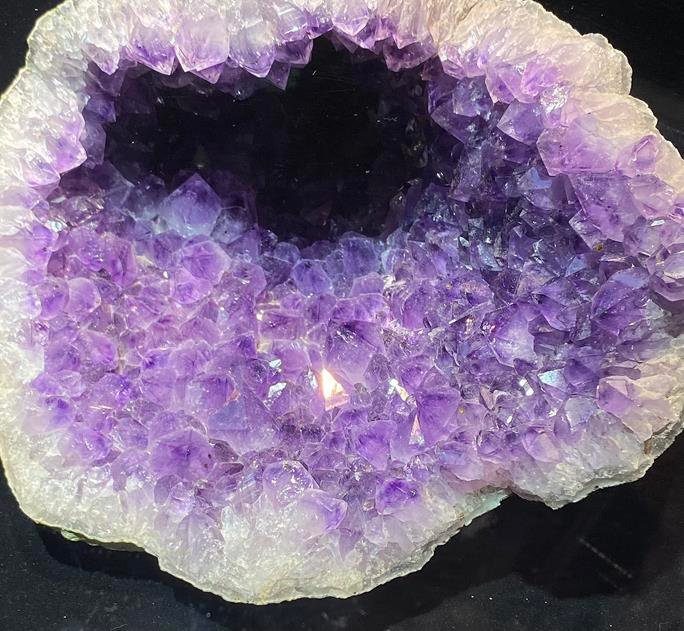Since they resemble each other, it is good to discuss geodes vs. thundereggs, nodules, vugs, concretions, and other similar structures in rocks.
This should help resolve any confusion since some authors often refer to geodes as concretions, nodules, thundereggs, etc.
What are geodes?
Geodes are hollow or partially filled subspherical, globular, or sometimes oblate discrete rock structures lined with mineral masses or crystals that grow inward to the core.
They occur in stratified volcanic rocks like lava flows, ash deposits, tuff, sedimentary rocks like limestone beds, dolomite, or sometimes shale or other rocks.
Geodes have a hard, more weathering-resistant outer layer or shell than the surrounding wall made of chalcedony, a microcrystalline silica. Thus, they will form discrete structures as the enclosing bedrock weathers away.
Therefore, as bedrock weathers, geodes will accumulate in stream valleys, in soil formed, canyons, and talus, or they can be scattered.

1. Geodes vs. thundereggs
Thundereggs are nearly spherical rock bodies filled with mineral masses or crystals. They occur in rhyolitic lava flows, tuffs, or ash layers.
These rock bodies form when mineral-rich hydrothermal fluids or groundwater seep into and form mineral crystals.

Both geodes and thundereggs are discrete rocky bodies with nearly spherical bodies with mineral masses or crystals. However, they have differences.
Firstly, geodes differ from thundereggs since they are hollow or partially filled with mineral masses and crystals, while thundereggs are filled, i.e., they don’t have cavities.
Secondly, thundereggs occur in rhyolitic lava flow, tuffs, or ash layers. In contrast, geodes can occur in volcanic and sedimentary rocks, mainly limestone, dolomite, and sometimes shale.
Lastly, thundereggs form only in vesicles, i.e., bubbles formed as gases exsolve from lava, while geodes can form vesicles or dissolution or decay of enclosed organic matter, concretions, or nodules.
2. Geodes vs. concretions
Concretions are compact, spherical to disc-shaped cemented mineral masses in rock layers, especially shales, sandstones, or limestones. You can mistake them for fossil eggs, bones, or turtle shells. However, they aren’t.
Concretion differs from geodes as they aren’t hollow towards their core. Also, they form and grow from their cores outwards, not inwardly.
Also, most nodules are non-crystalline, i.e., they don’t have crystals inside like geodes.
Lastly, they sometimes can have any shape that is not the nearly spherical shape common in geodes.
3. Geodes vs. nodules
Nodules are knobby, nearly spherical to irregularly rounded masses, lumps, or mineral aggregates in sedimentary rocks.
Most are made of minerals like apatite, anhydrite, pyrite, chert, or calcite, and their composition differs from the rocks in which they occur.
Nodules differ from geodes as they lack voids except a few, which may have tiny voids. For those with tiny voids, the size of cavities becomes a differentiating factor.
Furthermore, nodules form by precipitation from the center of a nucleus and grow outwards. In contrast, geodes grow from inner walls inward towards the core.
4. Geodes vs. vugs
Vugs are small to medium irregular cavities often lined with mineral crystals. They form in various ways, including vesicles and cavities created by tectonic movements or dissolution.

Geodes differ from vugs as they have a strong, weathering-resistant outer layer or wall that allows them to exist as discrete bodies. In contrast, vugs occur within the host rock body or matrix and don’t have strong walls to maintain their integrity.
Put differently, vugs are embedded in the host rock and lack a sturdy wall to occur independently as discrete rock bodies, while geodes do.
5. Geodes vs. spherulites and lithophysae
Spherulites are small, ball-like, or globular structures in glassy volcanic glasses filled with dense, fibrous, or acicular crystals radiating from a common center.

On the other hand, lithophysae are lenticular to nearly spherical spherulitic bodies with onion-like or concentric shells and cavities.

Geodes differ from spherulites since they are hollow or partially filled and don’t have acicular crystals radiating from a common center.
